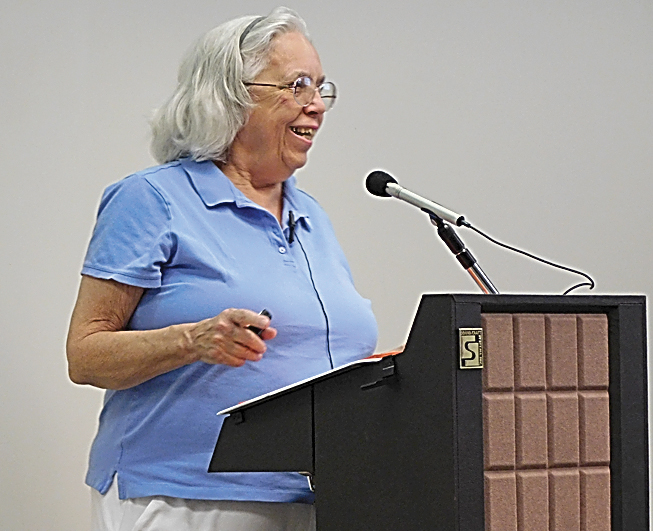Historian examines aftermath of US-Dakota War

Staff photo by Clay Schuldt Historian Mary Bakerman speaks about the aftermath of the US-Dakota War in a talk Friday afternoon at the Brown County Historical Society Museum annex.
NEW ULM — Historian Mary Bakerman gave a presentation Friday on the immediate aftermath of the Dakota-U.S. War of 1862.
The presentation was part of the Brown County Historical Society’s (BCHS) 156th anniversary commemoration. Bakerman’s presentation “After Wood Lake” was held in the BCHS Annex.
Bakerman had previously spoken about the depredation claims filed following the Dakota-U.S. Conflict, but recently she has researched what happened to the people directly impacted by the war.
Bakerman said her interests were not with the battles, but with the people. She wanted to examine a small period of time in the weeks following the conflict.
The Battle at Wood Lake had brought the conflict near to a close. Bakerman said the Dakota had planned an ambush near Wood Lake, but the 3rd Minnesota had stumbled upon the Dakota while foraging for food. The failed ambush resulted in most of the Dakota fleeing and Dakota releasing 250 captive whites. The military captured 2,000 Dakota soliders. Open warfare was over, said Bakerman, but the problems were not done.
Henry Sibley was in charge during the final battle, and was now faced with several responsibilities. He needed to take Dakota into custody, hold trials for combatants, return captives to their families, ensure safety for all and feed every person and animal in his protection.
Sibley had to do these things while reporting to superiors. The highest ranking superior in state was Gen. John Pope.
Pope did not want to be in Minnesota. He had been banished to the west for his failures in the War against the South. Pope had famously said his purpose in the west was to exterminate the Dakota.
Bakerman said Sibley had a divided heart over the Dakota and sought a less drastic approach, but that made things more complicated.
Bakerman clarified that before the war and after the war the Dakota people were divided over taking up arms against white settlers. She said the traditional Dakota wanted war, but other groups wanted peace and were willing to take up a farming life alongside white settlers. Bakerman refered to these Dakota as the “Farming Dakota.”
In the aftermath of the conflict many of the Farming Dakota, who did not participate in the fighting and had even protected white prisoners, were in danger from reprisal attacks. Even though the Farming Dakota were innocent, many white settlers were nervous and afraid. As a result the military needed to send entire families east in addition to the combatants standing trial.
The Farming Dakota were sent north to Fort Snelling and the Dakota on trial for war crimes were sent south to Mankato.
Bakerman said the two groups were split up as a diversion to prevent angry white settlers from attacking the Dakota. The wagon train of Dakota families heading to Fort Snelling was four miles long and moved at two miles an hour. Despite the diversion, both groups were attack by white settlers in route to their destination.
Even after reaching Fort Snelling, the Dakota families were not out of danger. Disease spread through the camp and hundreds died. They were eventually sent south into Iowa, then to Missouri and eventually Nebraska.
Some Dakota remained in Nebraska while others went to the Crow Creek reservation in South Dakota.
Bakerman said some of the Dakota combatants who were never captured headed west into South Dakota or into Canada. The ones fleeing to Canada sought protection from the British.
The white refugees of the war were free, but many could not return home. By the end of October, 928 white refugees were still be looked after by the military looking for a home. By 1863, the number of refugees was still 500.
Bakerman said part of the problem is many of the refugees had no where to go. The farm was lost in the war and it was too late to raise crops.
Other refugees were widowed in the war. Single mothers in the 1860s had few options. Many married into another family for support or went east to find other family. A few widows were able to secure a pension if their husband was killed in a military action.
Those with a family and farm to return to were still nervous about another potential attack. The war had resulted in mental trauma for many. At the time there was no mental hospital in Minnesota for treatment. The nearest mental health hospital was in Iowa and that facility was overwhelmed due to the Civil War.
Bakerman said it was no coincidence the hospital in St. Peter was founded after the war.
Bakerman said it was confusing and terrifying time for many people, though some people did return to the Minnesota River valley and make a life following the tragedy of war.
The Dakota-U.S. War commemoration week will continue Saturday with a series of walking tours through downtown New Ulm.
At 10:30 p.m. a tour for children will be held, followed by an adult tour at 1 p.m. Both tours start at the BCHS.





